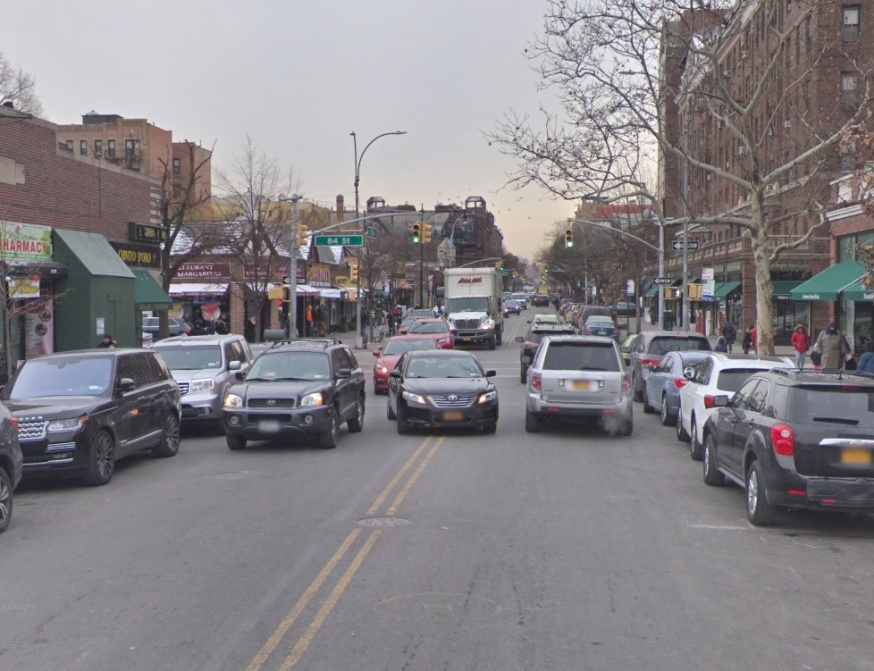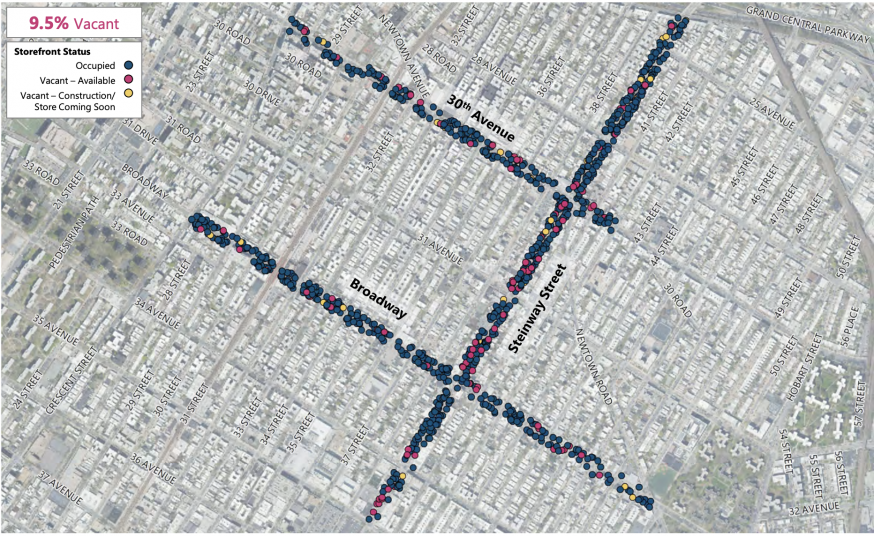
37th Avenue retail district (Google)
Aug. 8, 2019 By Allie Griffin
According to a new report on storefront vacancy, three Queens neighborhoods have healthy and robust retail economies and Jackson Heights has the lowest percentage of vacant storefronts among the 24 New York City neighborhoods studied in the report.
The report, titled Assessing Storefront Vacancy in NYC, released by the Department of City Planning (DCP) studied recent retail trends and storefront vacancies throughout the city by surveying shopping corridors in 24 neighborhoods across the five boroughs.
DCP analyzed 10,000 storefronts using third-party data based on on-the-ground surveys, as well as demographic, land use and real estate data and input from local business associations.
The study focused on continuous, pedestrian-oriented shopping corridors, excluding shopping malls and auto-oriented strips and studied trends from late 2017 to fall 2018.
Jackson Heights’ retail scene proved to be the most bustling with the lowest amount of storefront vacancies at just 5.1 percent. The neighborhood’s shopping corridor studied in the report included Roosevelt Avenue, 37th Avenue and Junction Boulevard.

Jackson Heights | DCP
The study found that while some neighborhoods have higher concentrations of vacancies, there is no overall trend city-wide. Reasons for these vacancies also differed based on neighborhood demographics and market trends and couldn’t be attributed to a single factor, according to the report.
A 5 to 10 percent vacancy rate is generally considered to be “healthy” by the industry, according to DCP.
The two other Queens neighborhoods surveyed were Laurelton and Astoria, which both had healthy rates of vacancy at 8.3 percent and 9.5 percent respectively. Merrick Boulevard was studied in Laurelton and Steinway Street, Broadway and 30th Avenue were the corridors studied in Astoria.
According to DCP, neighborhoods like the ones chosen in Queens — and generally in areas farther from Manhattan, appeared to benefit from solid customer bases and little market volatility.
However, the study points out that Astoria’s overall 9.5 percent storefront vacancy rate doesn’t capture the full picture from street to street.
Portions of Steinway Street have up to 18.1 percent vacancy, while 30th Avenue has just 7.5 percent vacancy, according to the report. It suggests that the decline in “dry retail” stores that sell items like clothing, furniture, books and electronics both on the block and citywide, has contributed to the higher number of empty storefronts. Meanwhile, 30th Avenue has become a restaurant corridor with businesses flowing.

Astoria | DCP
Astoria’s case study illustrates the larger retail trends observed in the report citywide. New Yorkers are buying their dry goods online as opposed to at retail stores, but are frequenting restaurants, bars and local services in growing numbers.
“In an ever-changing city where neighborhood shopping is an important facet of urban life, it’s crucial that we put as much reliable data as possible into the hands of business owners, residents, policy makers and elected officials. DCP’s research shows that the reasons for storefront vacancies are complex and varied and that solutions must be nuanced and targeted – or we may do more harm than good,” DCP Director Marisa Lago said. “And, encouragingly, our research also reveals that many community shopping districts are thriving.”
11 Comments




Many business are hard working and do the right thing…
But on 73rd ( between 37 ave and Broadway) it’s a complete disaster. Dirty filthy sidewalks, 24/7 loitering, firecrackers set off at 1am in morning, sidewalks choked by street vendors and halal carts. Plus a nonexistent police presence ( thanks Mayor De Blasio! )
As a resident here, I can tell you the local business community fosters, encourage and tolerates this awful behavior. Store fronts and side walks are filthy and never washed or swept. Recently a massive fire broke out.
During community meetings, Business owners are dismissive of resident concerns. Saying all the crowds, noise, spitting and garbage are a good thing…it reminds them of Bangladesh!
Most Liberals and politicians like places like JH, it’s a cheap way to demonstrate that they believe in “diversity”…meanwhile they would never tolerate what goes on here in their own neighborhoods.
It’s a hypocritical condescending attitude masked by platitudes.
I’m South Asian, the residents here come from every part of the world…so save me the spin on being tolerant of other cultures.
Question…would this happen in the UES?
Walk down 73rd between Roosevelt and Broadway any morning before 5am and you won’t believe all the garbage and how bad it smells. Seeing rats run around eating garbage and comming out of buildings in Diversity Plaza is a sight to remember! You gotta see it to believe it.
You don’t know what you are talking about! This neighborhood is filled with illegals, a bunch of prostitution places, muggers, transvestites hanging in every corner of Roosevelt Ave., drug pushers name it they are all here!
Unfortunately, most are 99 cents stores. Nothing too upscale
Just look at all those double parked cars
Really how is that possible with all these dirty illegals here ? I thought they would be raping and murdering . Just goes to show you a community that stays together regardless of race ,Creed or code does well as long as they are strong together and keep big greedy corporations from ruining it. Been here 35 years hope to make it another 35 .
As a Hispanic I can actually say there’s is no “connected” community” no one gives a crap about each other but their business, each race talks so much trash about each other and don’t get along well. These white people think everything “diverse” is a utopia
The point isn’t that this is a utopia, but that no place is. Higher proportion of immigrants doesn’t make a place any less safe, like 30% of the country’s voter base loves to spout on about.
I agree. Queens is not the melting pot people make it out to be; it’s a collection of insular, ethnic enclaves.
Jackson Heights is a prime example. There are a few streets in the low 70s that are dominated by South Asians. The rest of the neighborhood is largely Latino. There are a few streets in the mid 70s to the low 80s where affluent white people live and it’s a known fact that a few co-ops discriminate against minorities.
The retail landscape in this neighborhood shouldn’t surprise anyone. Latinos care more about how they look and dress and eating fast food (hence Banana Republic Factory, Gap Factory, Old Navy, Carter’s, Foot Locker, McDonald’s, Burger King, Popeye’s, etc. on 82nd Street) than improving their lives socioeconomically.
Thanks in part to Danny Dromm. This community has become a dump with dirty Diversity Plaza that he had fixed up to hold his little rallies saying how wonderful he is while living in his enclosed co-op building. This attitude of “multiculturalism” that he promotes has helped to destroy the idea of a melting pot. He kisses the ass of every group he can grab onto. Thank goodness he will be out of office soon.
Another 35.l years.You need to leave now with that mindset. Move to a place where you can be around the “people like yourself “